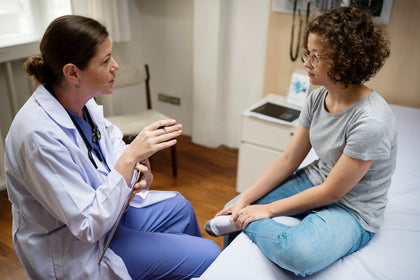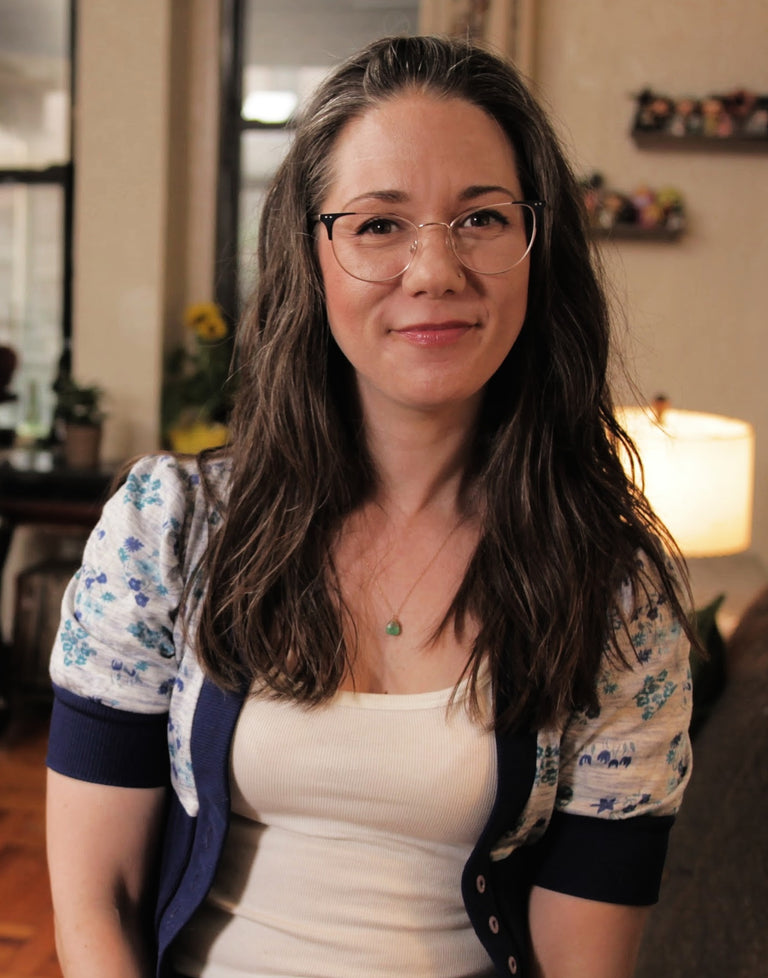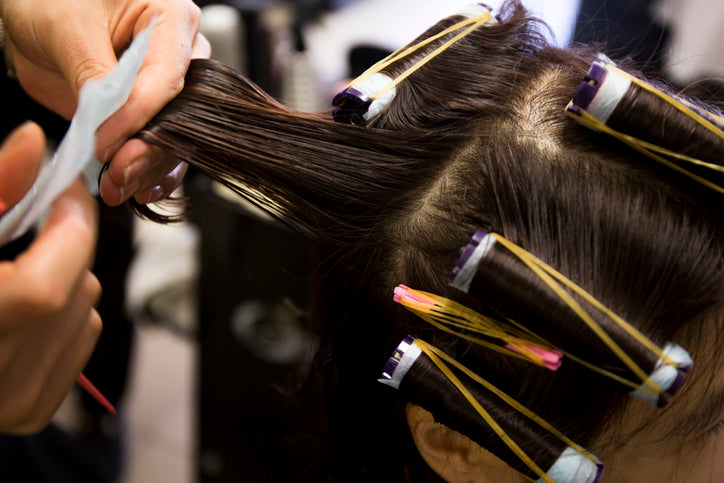For many cancer patients, the hair loss that comes along with chemotherapy treatment (also known as chemotherapy-induced hair loss) can be one of the most challenging parts of the diagnosis. While most people will return to normal hair growth after chemotherapy, there might be some changes to hair texture, type and growth.
After chemotherapy, some patients experience their hair growing out curly, which is often called “chemo curls.” What causes chemo curls? Are they permanent? Read on to understand how chemotherapy impacts hair follicles, along with what you can do to support regrowth with a holistic approach to hair health.
How Does Chemotherapy Impact Hair Follicles?
Chemotherapy is a treatment protocol used to treat cancer. There are a wide variety of different chemotherapy drugs used in varying doses and combinations, and they can be administered as pills, chemotherapy infusions (intravenous), shots and creams.
Since cancer cells proliferate through rapid division and replication, chemotherapy drugs target cells that divide quickly. However, these medications cannot differentiate between cancerous and healthy cells that also divide rapidly—like the cells produced by your hair follicles.
Each and every one of the hairs on your body is actually a collection of cells produced by the follicle. Within the hair roots, hair shafts are built cell by cell and pushed out to produce visible strands of hair. At any given time 90 percent of the follicles on your head are in this active phase of growth, called the anagen phase of the hair cycle, which is when they are rapidly producing cells to grow the hair shaft.
Because the hair follicle is producing cells quickly during the anagen phase, they can be inadvertently targeted by chemotherapy drugs, which is why chemotherapy causes hair loss in about 65 percent of patients. This type of hair loss is called anagen effluvium.
Follicles could continue to be affected even after treatment ends, potentially causing changes to your hair as it grows back, including “chemo curls.”
Read More: What You Need to Know About Cancer and Hair Loss
Hair Regrowth After Chemotherapy and Chemo Curls
For many patients, hair regrowth begins within just a few weeks of ending chemotherapy treatments. “Typically, the hair follicle restarts its normal cycling within a few weeks after the cancer treatment ends, and visible regrowth becomes apparent within three to six months,” Dr. Daniel Vorobiof, oncologist and chief medical director of Belong Life, told VEGAMOUR.
Hair might start to regrow with a very fine, soft and fuzzy texture that thickens back up over time. Hair might also grow back with a different texture and color, and between 53 percent and 65 percent of patients will see their hair become curly.
“We see in our patients that the new hair frequently has different characteristics, with changes in natural hair color and form (gray, curly, straight) likely due to differential effects of chemotherapy on the hair follicle pigment cells and inner root cells,” explained Dr. Vorobiof. “Generally, these effects resolve over time.”
Does Chemotherapy Always Cause Chemo Curls?
Not everyone will experience hair loss related to chemotherapy. It depends on a variety of factors, including an individual’s personal response to the medication, the type of medication, the dose and the frequency of administration.
“Higher doses of the biggest hair growth offenders will have a more dramatic impact on your hair follicles,” Dr. Cynthia Bailey, board-certified dermatologist and founder of Dr. Bailey Skin Care, told VEGAMOUR. Intravenous administration is also more likely to impact follicles, as is receiving a combination of different chemotherapy drugs.
There isn’t a lot of data as to how frequently people develop chemo curls, but in one patient survey, 53 percent reported their hair grew back curly.
Each person’s experience with chemotherapy will be different, so be sure to speak with your doctor about the chemotherapy drugs you’re taking and their protocol to understand better how likely they are to impact hair.
Related Reading: Why Does Chemotherapy Cause Hair Loss?
Holistic Support for Hair Health
Once chemotherapy treatment has ended, you might be wondering what you can do to support healthy hair regrowth. Healthy hair starts from within, so supporting your mental and general physical health are great ways to help your follicles recover. Here are a few hair care tips that might help.
Seek Out Support
Receiving a cancer diagnosis and the subsequent treatment can be a very difficult experience. The stress, anxiety and worry that might come along with it present unique challenges that can take a psychological and physical toll if left unattended.
Seeking out support is an essential part of any cancer treatment plan, according to the American Cancer Society. Not only can you speak with loved ones about how you’re feeling, but you might also want to seek out the help of a mental healthcare professional or join a cancer support group to speak with others who are going through similar experiences.
Focus on Overall Health
Focusing on pillars of health—such as sleep, exercise and diet—can go a long way in supporting healthy hair regrowth. Nurturing your body as a whole is an important part of recovery. Your bodies repair and restore cells while you sleep, exercise helps improve blood circulation (important for the functioning of follicles) and a varied diet focused on getting adequate vitamins and nutrients. Consider adding a hair-friendly supplement to your routine like VEGAMOUR’s GRO Biotin Gummies, which is formulated specifically to support optimal hair health.
Read More: Nutrition Tips to Support Hair Growth After Cancer Treatment
Be Gentle
“Your follicles need time to recover, so you want to treat your new hair gently,” advised Dr. Enrizza P. Factor, a board-certified dermatologist. Indeed, when your hair first grows back after chemotherapy, you might notice that its texture is finer and thinner than before. It’s important to avoid agressive styling of your post-chemo hair while the follicles regain function, so no tight ponytails or buns, heat styling or harsh styling products until your hair growth has returned to normal. Using a gentle shampoo and conditioner made from all-natural ingredients is another great way to treat follicles with some extra TLC.
Be Patient
Patience is another important part of the recovery process for follicles. While some patients see hair growth within just weeks of finishing chemo, it might take longer for others. Typically patients see natural hair regrowth within six months. Not only that, but as mentioned your hair might start to grow back fine and wispy, but generally will come back thicker and stronger over time. Hair grows at about ½ inch per month, so be patient while waiting to see normal hair return.
The Takeaway
“Chemo curls” is a term that refers to the changes that can happen to a cancer patient's hair after chemotherapy. Chemotherapy patients often see changes to their hair in color, texture and type after their cancer treatments, but these changes are most often not permanent.
Hair loss is often one of the most challenging parts of a cancer diagnosis, so be sure to speak with loved ones, fellow patients and mental healthcare professionals to help you navigate your treatment journey with as little stress as possible. Once you're on the road to recovery, support healthy hair regrowth with a shampoo and conditioner that provides your hair with the nutritional support it needs for sustainable, long-term wellness.
#include-related-slider#
More From VEGAMOUR
- Shop: Natural Hair Care Products for Wellness
- What You Should Know About Radiation & Hair Loss
- 3 Ways Nutrition Impacts Hair Growth and Loss
- These 12 Medications Might Cause Hair Loss
Photo credit: Rawpixel/iStock
Back


















